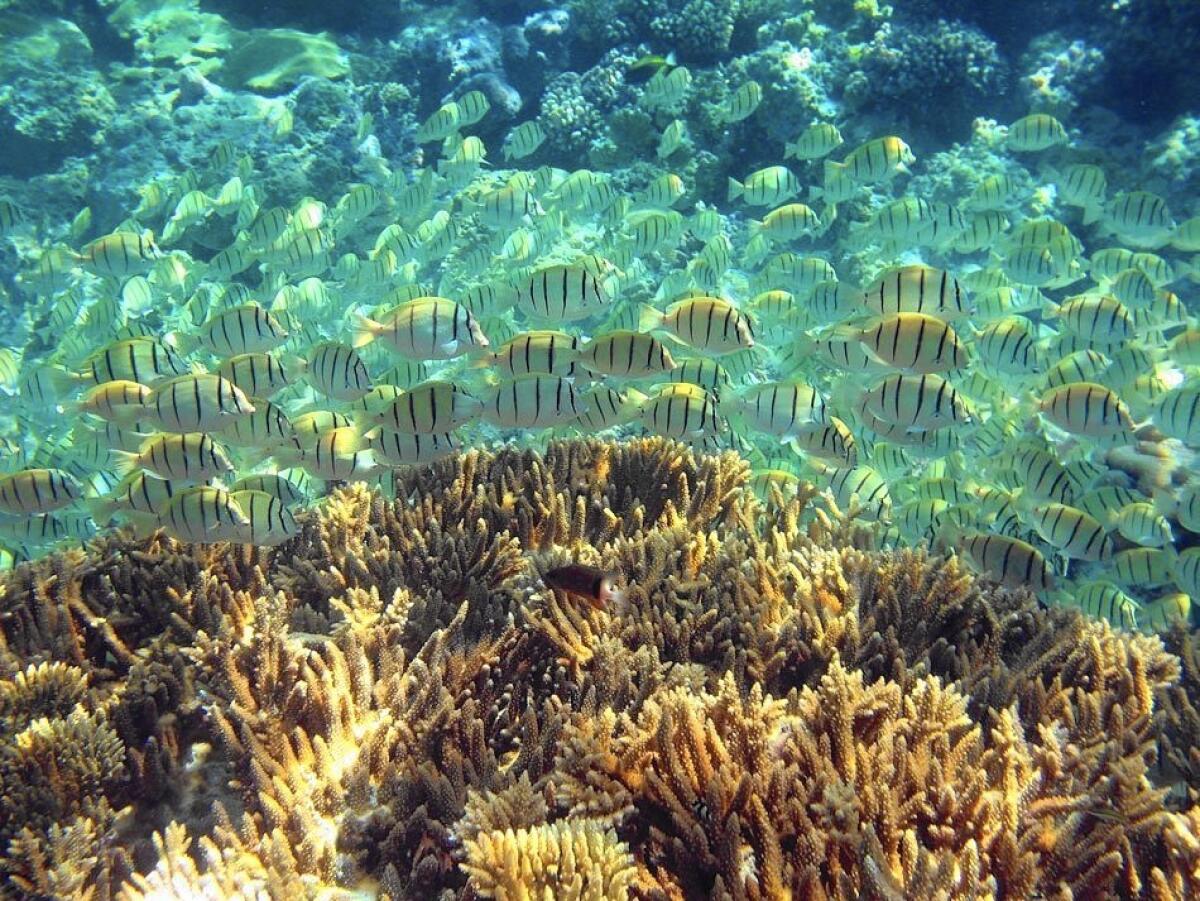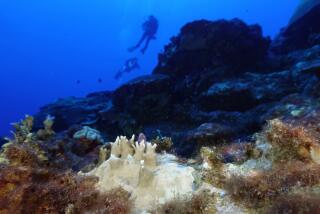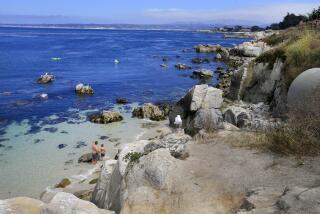These scientists studying coral reefs were brought to tears -- but in a good way

A school of convict tangs swim over a coral dominated habitat on Palmyra Atoll.
- Share via
As ocean warming continues to trigger widespread destruction of coral reefs, a decade-long study of remote islands in the Central Pacific suggests these biodiversity hot spots may thrive despite the threats posed by an increasingly hotter planet.
With many parts of the globe in the grip of a nearly two-year coral reef bleaching event — fueled in part by El Niño-driven ocean warming — scientists and marine conservation advocates have feared many reefs could suffer irreparable damage and fade from existence in coming decades.
A new report from the Scripps Institution of Oceanography in San Diego provides reason for optimism.
See more of our top stories on Facebook >>
In a massive project spanning 56 islands, researchers examined 450 coral reef locations from Hawaii to American Samoa, with stops in the remote Line and Phoenix islands as well as the Mariana Archipelago. Their results — published in the journal Proceedings of the Royal Society B — show that coral reefs surrounding remote islands were dramatically healthier than those in populated areas that were subject to a variety of human influences.
“There are still coral reefs on this planet that are incredibly healthy and probably look the way they did 1,000 years ago,” said study leader Jennifer Smith, a professor at Scripps’ Center for Marine Biodiversity and Conservation.
“The scientists were practically in tears when we saw some of these reefs,” she added. “We’ve never experienced anything like it in our lives. It was an almost religious experience.”
Teeming with sharks, manta rays, jellyfish and sea turtles, the remote locations contrasted starkly with the heavily populated areas, which were encircled by coral reefs smothered by murky seaweed and lacking much of the colorful algae that helps to cement a reef.
In recent decades, coral reef ecosystems worldwide have suffered significantly from overfishing, coastal development and the dumping of toxic substances into ocean waters. Scientists have predicted that up to 70% of coral reefs could be lost by mid-century.
Occupying less than 0.1% of the ocean’s sea floor, coral reefs are estimated to be home to nearly a quarter of all marine species. They also provide several human benefits, including food, tourism and flood protection for coastline developments.
After El Niño conditions in 1998 caused widespread bleaching, some coral reefs struggled to bounce back.
Bleaching occurs when water temperatures rise to such a degree that corals lose a symbiotic algae that lives in their tissue and provides food. In such cases, the bleached limestone reefs can become overgrown with seaweed that claims real estate once occupied by the corals. The leaching of nitrogen-based fertilizers into oceans and overfishing of herbivore species that mow back seaweed have been linked to this process.
In healthy conditions, reef skeletons repopulate with invertebrate coral animals as well as a vibrant, multicolored crustose coralline algae that works as a mortar to hold the marine city together and protect it from storms.
“After a bleaching event, it really matters what happens to all those dead skeletons,” Smith said. “Do they get colonized by big seaweeds, or do they get covered by coralline algae, which are providing settlements for baby corals and providing an environment that facilitates recovery.”
She and her Scripps colleagues discovered that while the tan-colored hard coral was only slightly more abundant around uninhabited islands as opposed to populated areas, the multicolored coralline algae was nearly 40% higher in the remote locations.
Finding abundant coralline algae in remote locations builds on previous data that suggest some reefs are better positioned to bounce back from adverse conditions, said Mark Eakin, coordinator of the Coral Reef Watch program from the National Oceanic and Atmospheric Administration.
“Those reefs where we’ve seen the best bounce-back from the 1998 event are those ones on the uninhabited islands,” he said. “Those reefs that are uninhabited are those that tend to have the crustose coralline algae filling the noncoral space on the reef.”
The new results may catalyze coral reef preservation efforts, which some have viewed as futile, said Stephanie Wear, senior scientist for the coral reef conservation program at the Nature Conservancy.
“I think it can energize people who are responsible for managing [reefs] that what they’re doing really does matter,” she said. “There are certainly people out there who have said, ‘There’s no point; climate change is going to be the end of reefs,’ and I absolutely disagree with that.”
Still, localized efforts to safeguard coral reefs will likely stave off the worst impacts of global warming for only so long, said Nancy Knowlton, a coral reef biologist at the Smithsonian Institution.
“The question is, how long will reefs be able to stay healthy in the context of much more frequent warming events and ocean acidification?” said Knowlton, who previously worked at Scripps and participated in the coral reef project’s initial research. “I think most reef scientists will say there are limits.
“What this study shows is that protection in a variety of different ways buys us incredibly valuable time while we figure out how to deal with the threat posed by climate change,” she added.
Though the most recent data from the study was taken in 2009, the researchers are continuing to monitor the Central Pacific islands they visited earlier. In many of the remote island locations that boasted the healthiest coral reefs, significant bleaching has occurred in the last two years amid the latest El Niño period, Smith said.
“I can’t tell you what the outcome is, because we’re still in the middle of it,” she said.
Smith plans to return to the islands again this summer. Her team’s future research could change how scientists determine the health of coral reefs, especially if coralline algae is found to significantly facilitate coral recovery after dramatic bleaching events.
joshua.smith@sduniontribune.com
Joshua Emerson Smith writes for the San Diego Union-Tribune.
MORE SCIENCE NEWS
Intensive exercise may keep the aging mind sharp
Study tallies the payback for humans and planet of eating more plants and less meat
To save native island animals from extinction, eradicate the uninvited guests, study finds






